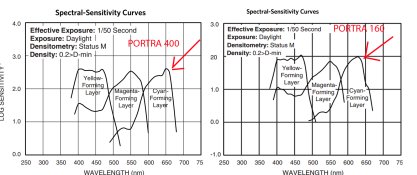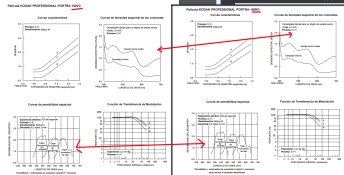Sorry, I was not aware you asked that.
Portra 160 vs 400 cannot be totally emulated because spectral response is different, a 3D LUT (or other) may work in certain conditions but if you change illumination or subject's reflective spectral nature then you may have a mismatch.
Look, Portra 400 has a different spectral sensitivity in the red channel than Portra 160:
View attachment 242056
_________________________________
Instead
Portra 160 NC and VC had the exactly the same spectral sensitivity, wich allows a perfect match with a 3D LUT
View attachment 242057
Some colorimetric concepts require math that's not basic.
After first Developer both NC and VC will deliver the same metallic silver densitities in each of the three color layers, at this stage color information is encodeed in a (math ) 3 dimensions real space, 3 optic densities and no spectrum, let's call XYZ those three densities encoding color in that intermediate stage.
1st developer seen as a transfer function is a Surjection in what for each (exposed) spectrum reaching film you have a point in a XYZ. Spectrums are in a Space of Functions, the Surjection assigns an XYZ point in the 3D real space for each exposed Spectrum. It is a Surjection because several spectrums may deliver the same XYZ, but you can't recover the original Spectrum from the XYZ values, let me reiterate that XYZ are metallic silver densities for each of the 3 channels at this stage.
If you consider that Second developement plus scanning is a "blackbox" transfer function, here you have a Bijection, for each point in the XYZ silver density 3D space you have an RGB point in the sRGB space, no information is lost because
transfer fuctions are Monotonic in the cross-channel sections, so you would be able to recover the XYZ point from the RGB value.
In the Portra NC vs VC you start from a common XYZ point and you end in two RGB values, one for NC and another one for VC, each of the transfer functions are Bijections, so also there is a Bijection maping RGB in the NC space with RGB in the VC, this means that a 3D LUT will perfectly map NC vs VC, not matering illumination kind or subject's spectral reflectivity, because this only changed the XYZ value that is the same for NC than for VC.
Instead this is not possible in the Portra 400 vs 160, because we depart from different XYZ spaces from different spectral responses.
Those theoric concepts are ususally not much needed in pictorial practice, but we the technicians that work with technical LUTs we need to have those concepts very clear.















